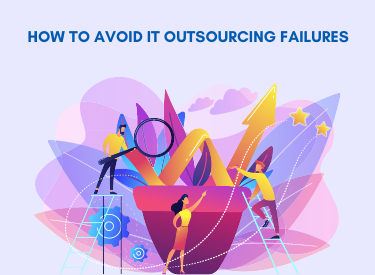How to Avoid IT Outsourcing Failures

How to Avoid IT Outsourcing Failures

With the industry’s globalization and the continual growth of technology, many organizations are finding it more challenging to develop a full range of software solutions in-house. They are forced to maintain a competitive advantage by constantly improving operational efficiency, customer service, and offering new products.
The global market value of IT services delegated to the leading IT outsourcing vendors is expected to hit $413.72 billion by the end of 2021, according to Statista. And the IT outsourcing trend will only intensify in the following years, with an annual increase of around 5%.
To remain competitive in today’s business environment, you must undoubtedly outsource company jobs and activities that someone else can accomplish faster, cheaper, or more effectively than you. Unfortunately, most entrepreneurs and small business owners make several mistakes when they first start outsourcing.
This article will discuss various IT outsourcing failures that can occur during the outsourced process and how to avoid them.
Why Does Outsourcing Fail?
Along with embracing new technology, organizations find developing diverse creative software solutions in-house challenging. That is why companies employ outsourcing services to create a successful plan by recruiting a dedicated IT outsourcing team of developers.
However, it is not as straightforward as it imagines: “outsourcing as a concept is changing from making it run to making the change happen,” according to Deloitte.
This indicates that you must not only implement the system but also gain the benefits of its performance while efficiently dealing with any challenges that may arise along the route. For example, the following are the most frequently encountered outsourcing issues:
- Breakdown in communication between the firm and its outsourced providers
- Lack of trust in outsourcing providers
- Lack of optimization and improvement skills
- Lack of risk assessment and a misdirected development strategy outsourcing worker irresponsibility
Indeed, these are just a few factors that may contribute to an organization’s numerous IT outsourcing failures. However, suppose you continue to feel that these are minor difficulties with outsourcing that have little impact on the overall situation. In that case, the Forbes data below may change your mind: Up to 25% of outsourcing companies fail within the first two years, and 50% fall during the first five years of collaboration.
Let’s take a closer look at the most likely IT outsourcing blunders your company must avoid to survive.
1. Different time zones
Communication gets difficult when you live in different time zones because your work hours sometimes do not coincide. That is why, when choosing an outsourcing partner, keep time zone differences in mind, as you will need to interact frequently to guarantee that your expectations are met.
2. Establish your outsourcing goals and scope of work.
You will never arrive if you do not have a clear destination in mind. After deciding to start an outsourcing project, you’ll need to figure out precisely what you want to outsource. Analyze your project to see what tasks you can do in-house and what skills you require.
An effective outsourcing plan must establish long-term and short-term goals, have a clear vision for the software development project being outsourced and offer documented roles and expectations for your IT outsourcing team.
Consider the future of your software product and how you expect your outsourced team to handle any changes. Your project will remain structured, and your outsourced staff will be on top of all responsibilities.
Read more: Top 6 Tips To Succeed in Outsourcing Software Development
3. Estimate the cost
The more precisely you explain what has to be done by breaking it down into components, the more precisely you can estimate how long it will take – and thus how much it will cost at the individual’s standard hourly rate. You don’t want to outsource work to someone and then be surprised when you get their bill or incorrectly assume they took too long to complete a task.
You risk paying significantly more than anticipated if you do not thoroughly assess all available costs for the services. As a result, prepare ahead, inquire about additional fees, and review client feedback.
4. Value is emphasized
While outsourcing can help you save money, it should not be your primary reason for doing so. Never think of outsourcing as a low-cost, simple way to unload work. Outsourcing should optimize your business, allowing you to focus more on critical initiatives.
The fees charged by your outsourcing company are frequently a reflection of its employees’ talents, expertise, and job quality. By putting value ahead of price, you reduce your chances of wasting money and receiving a defective product.
5. Select a Reliable Vendor
Your best bet is to work with a service provider who understands your industry and is aligned with your company’s goals and culture. Taking a bit more time when choosing a partner may thus save you a lot of trouble in the long run.
You should communicate the desired goal to the software development company, solicit and listen to their proposals, and rely on their knowledge and skills to achieve it.
Read more: How To Outsourcing Web Development in 2022
6. Develop an Effective Communication Model
In research, ineffective communication has been recognized as a key reason for project failure. Communication is essential when working with an offshore outsourcing workforce in a different time zone. You must create a successful communication model, which begins with establishing a line of communication with the offshore workers.
You could do this using video conferencing and instant messaging tools. You should also schedule regular meetings and follow-up conversations to ensure that all topics are covered.
7. Prioritize relationships over software.
It is easy to neglect the importance of personal ties in favor of project accomplishment. The irony, however, is that a strong connection will ensure the success of an outsourcing agreement far more than even the most painstakingly designed contract.
Remember that personal connections built on mutual trust and respect provide additional motivation for your remote employees. Invest some time and effort in creating a good, engaging, and inspiring work environment to inspire your remote staff to go the additional mile. An open-door policy may also decrease confrontations, misunderstandings, and distrust when everyone feels comfortable contacting you and addressing their difficulties.
Read more: How To Handle The Top 5 IT Staff Augmentation Challenges
Final Thoughts On Preventing IT Outsourcing Failures
Partners must communicate effectively and expect overseas personnel to avoid IT outsourcing failures. Furthermore, you must develop a formal written contract, directly resolving cultural or technical problems while remaining involved in project administration.
Organizations imposing excessive expectations on the outsourced team is the most common source of friction. Fortunately, there are several strategies to improve outsourcing. Several of these include conducting adequate supplier research to ensure that you select the greatest match for your firm. Furthermore, you must set realistic project objectives, communicate effectively with your outsourcing agency, and have a well-defined scope of work.
Overall, although there will always be challenges and impediments to a project’s success, just like in any other industry, however, the benefits of software outsourcing for many businesses far outweigh the risks.
When you engage committed resources with the right abilities based on your specifications, you can complete your project more quickly, economically, and efficiently. Recognizing the risks and implementing a nearshore outsourcing strategy sets the stage for your company’s success.



